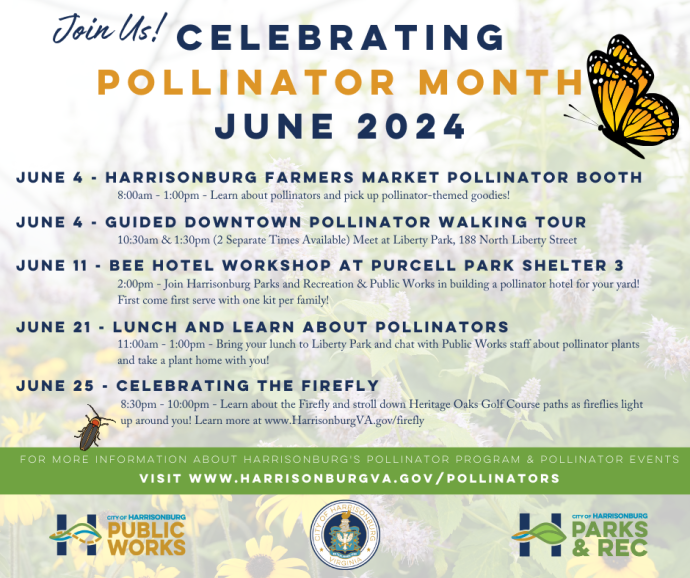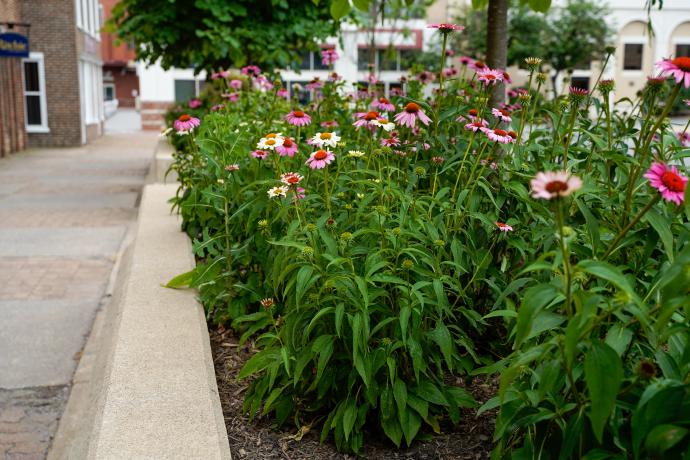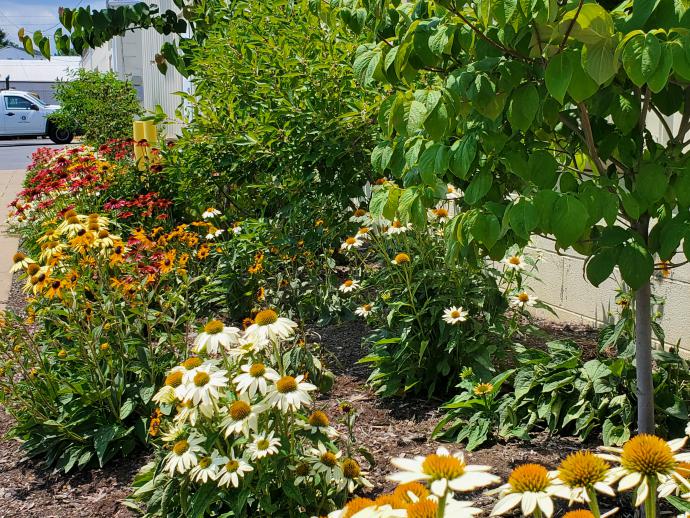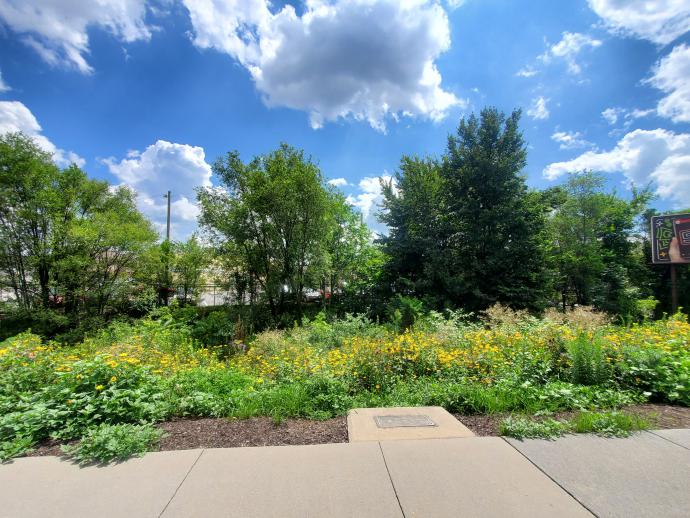
Harrisonburg as a Pollinator-Friendly City
Celebrate Pollinator Month with us!
June is National Pollinator month and the City is celebrating big this year! With the establishment of a pollinator corridor and many community partnerships formed through Harrisonburg's Pollinator Program, the City has decided, this year, to celebrate Pollinator Month all month long rather than just during the popular "pollinator week" June 17-23, 2024. Harrisonburg Public Works has gathered up other City departments and local partners to offer the Harrisonburg community (and visitors) a month long schedule of events and activities! Check out the list of pollinator events below:
- Harrisonburg Farmers Market - June 4, 8:00am - 1:00pm - Come visit our booth and learn about pollinators! Stop by and pick up your own pollinator themed goodies and learn about all the fun activities taking place during Pollinator Month!
- Guided Pollinator Walking Tour - June 4, 10:30am and 1:30pm (Two seperate times available) - Meet at Liberty Park, 188 North Liberty Street, Harrisonburg, for a guided downtown pollinator walking tour and discover what pollinators are in City spaces downtown! One tour will take place at 10:30am and a second tour will take place at 1:30pm.
- Bee Hotel Workshop - June 11, 2:00pm - Purcell Park 41 Monument Avenue, Shelter 3 - Building a pollinator hotel is a great way to attract solitary bees and other pollinators to your garden. Join Harrisonburg Parks and Recreation and Public Works in building a pollinator hotel for your yard. First come, first serve with one kit given per family. Once your hotel is complete, participants will learn how to use iNaturalist to identify local pollinator plants.
- Lunch and Learn about Pollinators - June 21, 11:00am - 1:00pm - Liberty Park, 188 North Liberty Street - Pick up your lunch from a Harrisonburg downtown restaurant or bring one from home and chat with City staff about pollinators, what to plant, native plants, pollinator-friendly practices, and more! Pick up your very own pollinator plant as you enjoy the beauty of the flowers in Liberty Park.
- Celebrating the Firefly - June 25, 8:30pm - 10:00pm - Heritage Oaks Golf Course, 680 Garbers Church Road - Enjoy the longest day of the year and the spectacle of thousands of fireflies. Enjoy a short educational session discussing the different types of fireflies in our area and why they are beneficial. As the sun sets and dusk arrives there will be the option to stroll down the paths at Heritage Oaks Golf Course and see the fireflies lighting up!
The Buzz Around Town - Pollinator Celebrations Taking Place by our Neighboring Partners this Summer - Schedule Coming Soon!
Press Release - February 15, 2023 Harrisonburg's Pollinator Program becomes a national example ![]() [484KB]
[484KB]
In early 2019, Harrisonburg Public Works and Parks and Recreation departments began planting pollinator spaces that are creating a pollinator corridor through The Friendly City.
What is a pollinator corridor and why is it important? A pollinator corridor is a pathway of gardens and meadows planted with native pollinator flowers, grasses, and trees that appeal to our native pollinator species of bees, butterflies, moths, birds, and even bats. This corridor planted through an urban area helps keep our local ecosystem working by providing a pathway for pollinators to travel, rest, and feed. Did you know 1 out of every 3 bites of the food you eat is thanks to a pollinator? That's right, pollinators touch 1/3 of the food we consume, over 150 food crops in the United States depend on pollinators.
Harrisonburg's pollinator corridor is made up of many small areas planted on public grounds. Some are as small as four square feet. Occasionally we are lucky to have a public space where we can plant a larger pollinator meadow. These spaces designed for pollinators are important because pollinators are facing global declines due to habitat loss, poor nutrition, and pesticide exposure and it is the City's job to make sure we are proactive in counteracting these issues. Staff, with the assistance of various local organizations such as the local Girl Scouts and First Presbyterian Church volunteers, have installed pollinator spaces in parks as a step toward addressing the urgent issue of declining pollinator populations.
Visit the City's Pollinator-Friendly Spaces

Pollinator spaces that city staff have installed and managed are listed in our Harrisonburg Pollinators Guide. Check out the story map to see all the new pollinator spaces we added this year.
Take the digital Downtown Pollinator Walk. This self-guided tour takes about 45 minutes, 20 minutes if you power walk, and hours if you stop to enjoy the amazing stores, shops, sights, and restaurants of Downtown. You can follow the interactive map that tells a little about each stop along the way, or you can download the Downtown Pollinator Walk Map ![]() [5MB] where the downtown pollinator spaces can be connected and enjoyed on a 1.1 mile.
[5MB] where the downtown pollinator spaces can be connected and enjoyed on a 1.1 mile.
The following locations are pollinator-friendly and include native plants but do not have maintained pollinator areas at this time:
- Westover Park
- Hillandale Park
- Purcell Park
- Heritage Oaks Golf Course
- Hillside along E Market Street in front of Gabe's & Hobby Lobby
- Many medians and roadsides no longer need to be mowed as frequently by Public Works as they have been transitioned to pollinator gardens
Establishing Pollinator Spaces

Just like any landscaping, pollinator spaces require planning, correct planting techniques, and maintenance in order to be successful. You can bring the beauty, and benefit, of pollinators to your home! You can create a pollinator space
at your home by planting a bed or meadow in your yard, or by planting in pots or planters on your deck, porch, or balcony. We do recommend you focus on native plants when planting a pollinator space.
- Planning and Planting: Pollinator Habitat should consist of native forbs, flowers, and warm-season grasses. All seed mixes or plugs planted for pollinator habitats within the city should be of native origin and appropriate seeding and planting rate. Starting with the right species selection for site conditions is paramount to pest management into the future. All ground to be planted should be surveyed and controlled for vegetative pest prior to planting either by hand pulling, mechanical control, or herbicide treatment. Soil should be cleaned of thatch (ideally burned) and slightly disturbed to ensure good seed to soil contact, but not deep-tilled in a way that encourages invasive vegetation. When possible, the seed should be drilled. If planting small beds, wildflower plugs should be used and mulched appropriately to smother competing vegetation.
- Maintenance: Pollinator habitat should be surveyed for invasive vegetation bi-weekly. Invasive or competing vegetation should be controlled by manual removal whenever feasible, mechanical mowing, or by spot spraying of herbicides. Over browse of nuisance deer should be dealt with by barrier fencing until the stand is fully established. Pollinator habitat should be mowed once a year during the dormant season to encourage new growth and removal of thatch from the previous growing seasons. Mowing or burning (where feasible) is the single most important pest management tool to control invasive and woody vegetation. Most insects that occupy native pollinator habitats are truly beneficial. Insecticides should not be sprayed in or near the pollinator habitat. The use of burning (where feasible) or mowing should control ticks to the appropriate level.
Types of Pollinator Spaces
There are two main types of pollinator spaces. The type of pollinator space planted depends on factors such as available space, the purpose of the habitat, and aesthetics.
- Pollinator Gardens: Pollinator gardens are small-scale (generally less than 1,000 square feet) areas that can provide an essential source of habitat for pollinators. They are sometimes converted from existing mulched beds and include native plants and plugs. These areas are more manicured than pollinator meadows.
- Pollinator Meadows: Pollinator meadows are areas of land converted from non-productive mowed fields or turf to pollinator habitat. These can be large scale (greater than 1 acre) or small scale. To establish a meadow, existing vegetation is removed, the seedbed is prepared, and a seed mixture of native plants and grasses are spread. In Harrisonburg, these sites include a mulched or mowed border and must be maintained to ensure invasive species are controlled.


Learn more about the City's efforts for creating Pollinator Spaces
- Press Release 3-20-2024: Harrisonburg Public Works to Host Pollinators In Your Yard Event
 [469KB]
[469KB] - Press Release 2-15-2023: Harrisonburg's Pollinator Program becomes a national example
 [484KB]
[484KB]  City Comprehensive Plan - Objective 11.2 and 11.4
City Comprehensive Plan - Objective 11.2 and 11.4 Environmental Action Plan - Land Use and Green Space, Goal 4
Environmental Action Plan - Land Use and Green Space, Goal 4- Harrisonburg Pollinators Guide
- Pollinator Corridor Map
- Digital Downtown Pollinator Walk
 [5MB] Downtown Pollinator Walk Map
[5MB] Downtown Pollinator Walk Map



